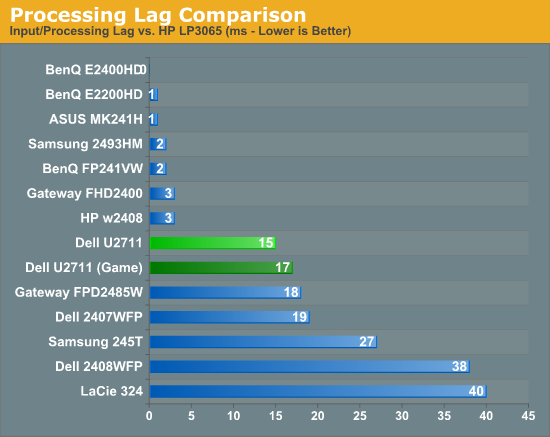Dell UltraSharp U2711: Quality has a Price
by Jarred Walton on January 22, 2010 2:00 AM EST- Posted in
- Displays
Dell U2711 Lag and Response Time
Some users are very concerned with display lag and pixel response time. For others, they really don't notice anything unless a particular display is very sluggish. I fall into the latter camp, though I do notice the processing lag when it's above ~40ms (e.g. on the Dell 2408WFP and LaCie 324, my mouse input just felt off.) To test for display lag, we run the Wings of Fury benchmark in 3DMark03, with the output set to the native LCD resolution - in this case 2560x1440. We clone the output to our reference LCD, an HP LP3065, snap a bunch of pictures, toss out any where the time readout isn't clear, and then average the remaining results (at least 10, and usually 20 or more).
As a reminder, the reference HP LP3065 is one of the best LCDs we currently possess in terms of not having display lag. (The lack of a built-in scaler probably has something to do with this.) While we know some of you would like us to compare performance to a CRT, few users have CRTs these days and all we're really interested in measuring is the relative lag. It's possible we will find an LCD that ends up with a negative result, meaning it's faster than the LP3065, but the best we have managed so far is a tie.

So far, all of the S-PVA panels we have tested show a significant amount of input lag, ranging from 18ms up to 40ms. In contrast, the TN and S-IPS panels show little to no processing lag (relative to the HP LP3065). The BenQ FP241VW with an S-MVA panel performs similarly to the TN and IPS panels, with an average display lag of 2ms - not something you would actually notice compared to other LCDs. What about the new U2711?
We tested with the "Graphics" setting and Adobe RGB as well as "Video" and "Game" - we figured the latter might disable some post-processing and result in less lag. That turned out to be incorrect, as our measured lag actually went up 2ms. However, in practice the settings are pretty much tied. That means the U2711 has around one frame of lag relative to our best LCDs, but it still has a lot less lag than our worst offenders. As stated already, I didn't notice lag in using the U2711 - just like I didn't notice lag on the 2407WFP or the FPD2485W. I did notice slight lag on the Samsung 245T and some clear lag on the 2408WFP and LaCie 324, but the threshold for lag varies and you'll need to determine if 15-17ms is too much or not for you. If you've tried any TN panels and still noticed lag, we would expect every current LCD to be above your "lag threshold".
 |
Despite what the manufacturers might advertise as their average pixel response time, we have found most of the LCDs are basically equal in this area - they all show roughly a one frame "lag", which equates to a response time of around 16ms. Some transitions are faster than others, but the above is representative of what we found in a study of numerous photos. If you look at the tail of the center plane, you can see a slight ghost image before and after the dominant frame. Some of that will come from the camera (we use a 1/120s shutter speed), but most of it comes from the LCD panel. In this case, the U2711 panel does outperform most LCDs that we've tested, where it was often possible to see at least three frames more clearly than the two slight ghosts in the above image.










153 Comments
View All Comments
poohbear - Friday, January 22, 2010 - link
a 27" lcd monitor review??? you guys should do your research and see what your users actually use, what portion of your demographics actually use a 27" $1000+ monitor? write articles that are practical for your users and that your users would be interested in, no this i have $1000 lying around and then ontop of that i have $700 for an sli or crossfire setup to handle the insanely high resolution for this monitor.i expected more from u guys.
Voo - Saturday, January 23, 2010 - link
Wouldn't that mean that AT also should stop reviewing new CPUs, because the majority of users only buy some cheap Phenoms or core2s?Would be rather boring.. not that you can't (and shouldn't) also review cheaper monitors, but I don't think it has to be a "either or".
Raoul Duke - Saturday, January 23, 2010 - link
As someone looking to replace a 30" LCD I completely disagree. This article had perfect timing for me as I was planning on purchasing the Dell 2709W next week. This was an article I found well written and informative.CSMR - Saturday, January 23, 2010 - link
Modern integrated graphics can handle this monitor. You just need a dual dvi output or displayport (or sufficiently good hdmi I guess).AnnonymousCoward - Saturday, January 23, 2010 - link
I spent $1500 on my 30". Worth every penny. And my car costs less than yours.kmmatney - Saturday, January 23, 2010 - link
I sort of agree. While its great to see reviews of high end monitors, there are also a lot more interesting monitors to review, such as the new e-IPS displays. I bought the new NEC 23" e-IPS display, and I also own a Soyo 24" MVA display. These were both around $300 (and the Soyo is better , btw, but you can't buy it anymore). Would be nice to see a review of the NEC or Viewsonic 23" eIPS displays.Pandamonium - Friday, January 22, 2010 - link
Maybe this is idiotic, but what if you mounted a midrange computer to the back of the panel? It shouldn't be too difficult to modify a shim to go between the panel and the stand that can hold a smallish desktop. Maybe I've been struck with the Apple bug, but there's something to be said for minimizing wire clutter. If Apple weren't hell-bent on proprietary video inputs, I'd be looking at the 27" iMac more carefully. So instead I'm trying to figure out how you could do something similar in the PC world.CSMR - Friday, January 22, 2010 - link
I wouldn't use apple if you gave me for free, but they do have better video connections than PC, PC makers have all these legacy connections including VGA while apple was quick to DVI and then displayport. They chose a strange displayport plug but that's all you can blame them for.But various PC makers have all-in-ones. I think Sony makes at least one with a good screen.
CSMR - Friday, January 22, 2010 - link
Good information about a good product I'll definitely consider. But I was disappointed by novice errors about pixel pitch.Claim: Small pixel pitch makes text hard to read. The windows dpi setting is limited to 96 and 120.
This is a particularly bad error because so many people fall for it. It's important for a tech site to hammer home the right answer here so that people set up their displays right. Smaller dpi always improves text. It doesn't make text smaller because you just adjust the dpi setting to whatever you want. Smaller dpi just gives better-resolved text. XP had problems but since Vista this has worked well in Windows so you shouldn't perpetuate this mistake.
(Now with icons and web images, yes you may get minor artifacts of scaling, but this is becoming less and less of an issue, and the lower the pixel pitch the less of an issue it is.)
JarredWalton - Friday, January 22, 2010 - link
The text isn't worse; it's simply smaller, and *that* is indeed harder to read for many people (especially those who are 40 and older).Changing the DPI will help with the text problem, true, but there are all sorts of other artifacts. Take web sites that tend to use a set width (AnandTech and tons of others). You can get big text with a change in DPI, but the images stay the same. It's not an ideal way of working.
Also, if you're working at a 120 DPI, documents and spreadsheets and such don't look the same on other PCs running the default 96 DPI. It's one of those "issues" I glossed over. Icons are another. When I switched, there were all sorts of oddities that I wasn't anticipating; I've mostly come to grips with them, but it would have been nice if the 120 DPI setting had just scaled everything but images "perfectly".
I suppose that ideally I'd want my text DPI set at 192 for some things, but I'd prefer my icons and Windows UI elements to stay at 96, and other areas would be nice to have at 120, and.... You get the point. I think by using the magnification capabilities of Word, Excel, and most browsers I can get around changing the DPI altogether... almost.
Basically, higher DPI (finer dot pitch) is good for some people and in some usage scenarios, and potentially bad in others, depending almost entirely on user preference. In the case of the U2711, I'd almost rather run it at 1920x1080 with sharpness at 60-70% than deal with the DPI stuff... expect I really like 2560 width when you work with large images.